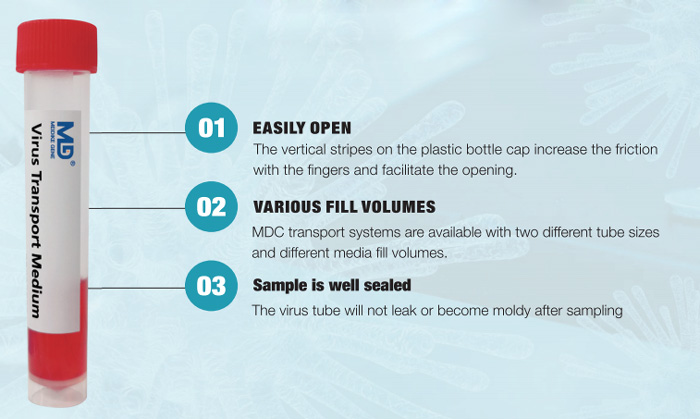
1. वायरस सैंपलिंग ट्यूब का क्या उपयोग है??
इसका उपयोग संग्रह के लिए किया जाता है, इन्फ्लूएंजा का परिवहन और भंडारण, एवियन इन्फ्लूएंजा, बाद के निष्कर्षण और प्रवर्धन के लिए कोरोनोवायरस और अन्य वायरस के नमूने.
2. निष्क्रिय और गैर-निष्क्रिय संरक्षण समाधानों के बीच क्या अंतर है??
वायरस के नमूने एकत्र किए जाने के बाद, सामान्य नमूना संग्रह स्थल पर पीसीआर परीक्षण समय पर नहीं किया जा सकता है, इसलिए एकत्र किए गए वायरस स्वाब नमूनों को ले जाने की आवश्यकता है. इन विट्रो में वायरस तेजी से विघटित हो जाएगा और बाद के परीक्षणों को प्रभावित करेगा. इसलिए, भंडारण और परिवहन करते समय, वायरस संरक्षण समाधान जोड़ना आवश्यक है, और विभिन्न पहचान इरादों के लिए, विभिन्न वायरस संरक्षण समाधानों का उपयोग करने की आवश्यकता है. वर्तमान में, इसे मुख्यतः दो प्रकारों में विभाजित किया गया है: निष्क्रिय और गैर-निष्क्रिय
निष्क्रिय वायरस संरक्षण समाधान:
यह मुख्य रूप से न्यूक्लिक एसिड निष्कर्षण और अपघटन समाधान द्वारा संशोधित एक वायरस लाइसिस प्रकार का संरक्षण समाधान है. ऑपरेटर को द्वितीयक संक्रमण से प्रभावी ढंग से रोकें, लेकिन इसमें अवरोधक भी शामिल हैं, जो वायरस न्यूक्लिक एसिड को ख़राब होने से रोक सकता है, और फिर एनटी-पीसीआर द्वारा बाद में पता लगाने को सक्षम करें. और इसे कमरे के तापमान पर अपेक्षाकृत लंबे समय तक संग्रहीत किया जा सकता है, वायरस नमूना भंडारण और परिवहन की लागत की बचत.
गैर-निष्क्रिय वायरस संरक्षण समाधान:
यह मुख्य रूप से एक वायरस-बनाए रखने वाला तरल-प्रकार का संरक्षण समाधान है जिसे डिलीवरी माध्यम के आधार पर बेहतर बनाया जाता है. यह इन विट्रो में वायरस की गतिविधि और एंटीजन और न्यूक्लिक एसिड की अखंडता को बनाए रख सकता है, वायरस के प्रोटीन कोट को विघटित होने से बचाएं, और वायरस सैंपल की मौलिकता को काफी हद तक बनाए रखें. न्यूक्लिक एसिड निष्कर्षण और पता लगाने के अलावा, इसका उपयोग वायरस की खेती और अलगाव के लिए भी किया जा सकता है.
इसे अलग-अलग परिस्थितियों के अनुसार देखा जा सकता है, विभिन्न प्रकार के संरक्षण समाधानों के अपने फायदे और नुकसान हैं, लेकिन यह ध्यान रखना चाहिए कि यह निष्क्रिय है या गैर-निष्क्रिय है, सैंपल लेने से पहले वायरस सैंपलिंग ट्यूब को सख्ती से निष्क्रिय और निष्फल किया जाना चाहिए ताकि यह सुनिश्चित हो सके कि ट्यूब अंदर है. कोई अन्य सूक्ष्मजीव नहीं हैं, जिससे नमूना लेने के बाद वायरस विघटित हो जाता है या अन्य प्रभाव गलत पहचान का कारण बनते हैं.
स्वाब सैंपलिंग के बाद, यदि आप खराब गुणवत्ता वाले संग्रह उपकरण या संरक्षण समाधान का उपयोग करते हैं, यह बाद के परीक्षण परिणामों को प्रभावित करेगा और गलत निदान के लिए गलत सकारात्मक परिणाम भी देगा. इसलिए, अच्छी गुणवत्ता वाले वायरस संरक्षण समाधानों का उपयोग करने की अनुशंसा की जाती है.
मेडिको वायरस सैंपलिंग ट्यूब:

3. वायरस का नमूना कैसे एकत्रित करें?
नासॉफिरिन्जियल स्वैब और ऑरोफरीन्जियल स्वैब नमूने के लिए संग्रह प्रक्रियाएँ:
नासॉफिरिन्जियल स्वैब संग्रह
1. रोगी का सिर पीछे की ओर झुका हुआ होता है (लगभग 70 डिग्री) और स्थिर रहता है.
2. कान की जड़ से नाक तक की दूरी का अनुमान लगाने के लिए एक स्वाब का उपयोग करें.
3. नाक से सीधे चेहरे पर डालें. गहरा करने का अंतराल इयरलोब से नाक की नोक तक की लंबाई का कम से कम आधा होना चाहिए. प्रतिरोध का सामना करने के बाद, आपको नासॉफरीनक्स तक पहुंचना चाहिए, स्राव को अवशोषित करने के लिए कुछ सेकंड रुकें (आम तौर पर 15-30), और स्वाब को घुमाएँ 3 को 5 टाइम्स.
4. स्वाब को बाहर निकालने के लिए धीरे से घुमाएँ, और स्वाब हेड को एक संग्रह ट्यूब में डुबो दें 2 लिसीस समाधान का एमएल या आरएनएएस अवरोधक युक्त सेल संरक्षण समाधान.
5. शीर्ष पर स्टेराइल स्वैब रॉड को तोड़ दें, पूँछ त्यागें, ट्यूब के ढक्कन को कसकर कस लें और इसे पैराफिल्म से बंद कर दें.

ऑरोफरीन्जियल स्वाब संग्रह
1. सबसे पहले मरीज को सेलाइन या पानी से गरारे करने के लिए कहें.
2. इसे गीला करने के लिए स्वाब को स्टेराइल सामान्य सेलाइन में डालें.
3. रोगी को बैठने पर ध्यान दें, उसके सिर को पीछे झुकाएं, उसका मुंह खोलो, और एक बनाओ “एएच” आवाज़.
4. जीभ को टंग डिप्रेसर से ठीक करें. स्वाब जीभ की जड़ से पीछे ग्रसनी तक जाता है, टॉन्सिल अवकाश, और साइड की दीवारें.
5. सबसे पहले द्विपक्षीय ग्रसनी टॉन्सिल को कम से कम आगे-पीछे रगड़ने के लिए स्वाब का उपयोग करें 3 टाइम्स, और फिर कम से कम पिछली दीवार को निगल लें 3 टाइम्स, अधिमानतः 3 को 5 टाइम्स.
6. जीभ को छूने से रोकने के लिए स्वाब को बाहर निकालें, पिट्यूटरी, मौखिक श्लेष्म और लार.
7. स्वाब हेड को एक संरक्षण समाधान में डुबोएं 2 को 3 वायरस का एमएल. 8. शीर्ष के पास स्टेराइल स्वैब रॉड को तोड़ दें, पूँछ त्यागें, ट्यूब कैप को कसकर पेंच करें और इसे पैराफिल्म से बंद कर दें.



















